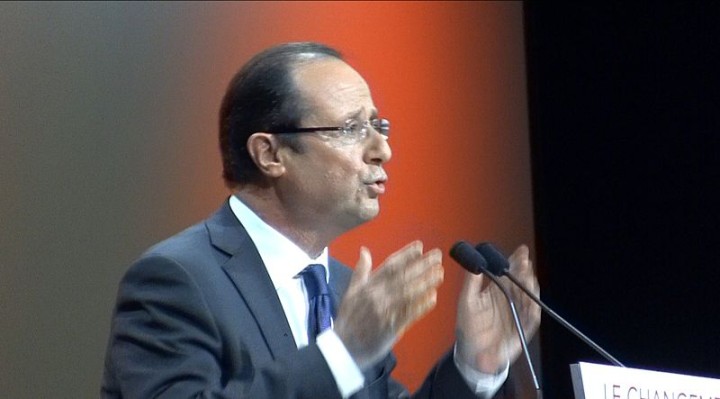“Switzerland would be a model to follow,” declared President Hollande after a two-day state visit to the Swiss Confederation. Let’s hope that he’ll encourage his diplomats to do just that, as they prepare for the April 27 opening of the 9th Review Conference of the Nuclear Non-Proliferation Treaty (NPT) at the UN: nuclear disarmament could then advance much faster!
We must recognize that these two states are opposed in considerable ways. Switzerland is a neutral state, which has thousands of fallout shelters and promotes a strong anti-nuclear policy. France has at its disposal the third-largest atomic arsenal on the planet and is a member of a nuclear-based military organization, NATO. France’s president has even proclaimed that its people’s ability to live freely is thanks to France’s deterrent capability (according to his speech at Istres 19/02/2015).
Switzerland, which renounced its nuclear program many decades ago, is one of the world leaders in disarmament. It has always been very active on the nuclear disarmament pillar of the NPT. Its role in aiding the adoption of strong measures by France and the other nuclear powers (USA, Russia, UK and China) during the previous Review Conference in 2010 was revealing. Those adopted measures were intended to strengthen the NPT’s credibility and help glimpse the possibility of a world without nuclear weapons. The nuclear powers agreed in 2010 to “adopt practical disarmament measures” and “redouble their efforts to reduce and ultimately eliminate all types of nuclear weapons.” Unfortunately, five years later, the lack of concrete results is bitter.
Concerning France, we must admit that it does not have a pronounced taste for nuclear disarmament. Paris has halved its nuclear arsenal in twenty years (300 weapons to date), but it has also vigorously engaged in and continued modernizing its submarine and air-based nuclear forces. Since 2010, its nuclear bomb has been developed to more quickly and furtively reach places using the stealth cruise missile ASMP-A (up to 500 km) or the M51 ballistic missile (up to 8000 km). Furthermore, its nuclear-testing simulation program ensures an endless technical renewal capacity, as evidenced by the recent production of two new nuclear warheads (TNA in 2007 and TNO in 2015). This vertical proliferation has even been praised by French Prime Minister Manuel Valls, who took pride in the fact that France “is leading the race for deterrence technologies” (23/10/2014). The desire to maintain nuclear deterrence, as a central element of its defense, is found constantly, both in the last White Paper on Defense and National Security (2013) and in the military planning law (LPM) 2014-2019, which budgeted an even higher deterrence budget of 23.3 billion euros, as opposed to the previous budget of 20.25 billion euros (2009-2014). Not only the lack of tangible progress by France and the other nuclear powers will undoubtedly be raised by Switzerland. Frictions will also be found and related to a movement which is also largely the cause of all this: the humanitarian dimension of nuclear disarmament. This diplomatic posture was introduced in 2011 and has helped trigger a cycle of conferences on the catastrophic consequences of the humanitarian impact of a nuclear weapon. The first of these conferences (Oslo in 2013, followed by Nayarit and Vienna in 2014) was described as a “distraction” by all the nuclear powers. But for Switzerland and 154 other states, the very existence of nuclear weapons creates a significant security risk for their populations.
Given the history since 1945, there is a risk of detonation of nuclear weapons, whether the cause is intentional or a mistaken assessment error, human folly or technical fault. It is clearly recognized, even before such a detonation, that nobody could ready an appropriate response to the humanitarian emergency it would cause due to its potential devastating dangers. But even if France denies the consequences of the use of a nuclear weapon, it refuses to officially acknowledge the risk of a serious military nuclear accident. But all this is a reality that cannot escape Swiss authorities, who are well aware of the proximity of the Valduc nuclear weapon production, maintenance and dismantling site (about 150 kilometers from the Swiss border). Without France’s implementation of disarmament measures that show “good faith”, French-Swiss opposition will remain. Their differences could increase much more, if Bern pushes for the adoption of a new binding legal instrument on nuclear weapons, as is being proposed by Austria. Will Switzerland still be “a model to follow” for President Hollande?
This is an English translation of Jean-Marie Collin’s (ALB Vice-president) op-ed in Le Temps (Swiss newspaper) from April 23, 2015. Translation by Professor Erika Simpson, Department of Political Science, Western University, Canada with assistance from Professor Pierre Jasmin, Department of Music, Arts Faculty, University of Quebec. Simpson is responsible for the translation from the text below and any translation errors are solely her own.






